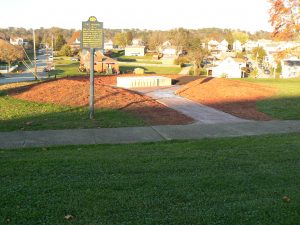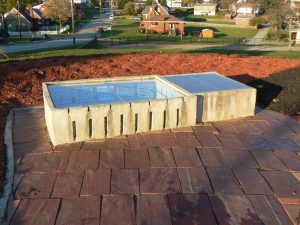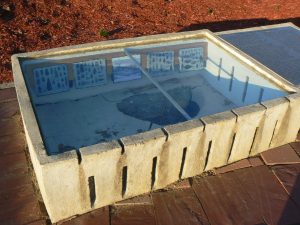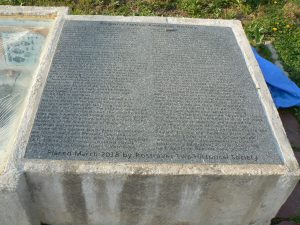The mid-twentieth century Pennsylvania historical marker in Monongahela City’s Memorial Park for Indian mounds Adena people raised over some of their dead is evidence that a generation which came of age during the first world war, survived an influenza pandemic, the Great Depression, and a second world war felt connected to the local culture two millennia earlier. The state marker’s text mentions the late-nineteenth excavation of the largest mound, the Crall Mound, recreated in an archaeological exhibit and contextualized on a granite historical marker.

PA historical marker and its elaboration



Regional Native American History marker
Regional Native American History
Cultures are a product of history. The Fa-
ther of American Ethnology, Albert Gallatin,
led a meeting of whiskey rebels near here.
James Adovasio stresses distinct populations in
the sixteen thousand years of regional human
activity his team uncovered in Meadowcroft
Rockshelter, Paleo, Archaic, and Woodland to
historical Native Americans.
Our region, 32 counties in four states, was
established by the Monongahela culture (A. D.
1000 to 1635), with a local geographical center.
Mound building during Adena (800 B.C. to
A.D. 1) and Hopewell (100 B.C. to A.D. 500)
times was centered near Chillicothe, Ohio.
Chillicothe remained central for Fort Ancient
(A.D. 1000 to 1650) builders of the misnamed
Serpent Mound (a fertility effigy), the Shawnee,
and the selectors of Ohio’s first state capital.
Don Dragoo in Mounds for the Dead notes
basic cultural continuity for the Adena along
with increasing Central American influences in
the Adena, Hopewell, and Mississippians.
Nineteenth century excavators measured
Moundsville, West Virginia’s late Adena Grave
Creek Mound at 69 feet, McKees Rocks Mound
at 16 feet, and the region’s third largest Crall
Mound at nine feet high by 60 feet in diameter.
The early to mid-Adena Crall Mound exhibit
features three of the burials found when a six-
foot-wide trench 35 feet long was dug from the
east circa 1886. The profiled central pit burial
held no artifacts, but the ritually killed tube
pipe fragment and folded over copper gorget
found with the other two burials are repro-
duced, evidence of the importance of trade in
materials and ceremonies.
Some of the earliest North American
mounds are found near Point Pleasant, Louisi-
ana, a practice that culminates with the Missis-
sipians (A.D. 800 to 1600), whose stratified
culture reached as far as Florida from its
Metropolis, Cahokia, Illinois.
Adena and Hopewell wealth stemmed from
proximity to the Flint Ridge quarries and the
associated trade routes that developed in
central Ohio, near the spectacular Newark
earthworks of the Hopewell.
Trade networks brought Mesoamerican
plants, cosmology, art, and horrific class dis-
tinctions, such as cranial deformation among
the elite still practiced by the Pacific Northwest
tribes Lewis and Clark met and trophy skulls.
A Rhode Island Indian told Roger Williams
their religion came from the southwest along
with corn and beans. While Northeast Indians,
including those locally, played the chunkey
game and adopted bows and arrows, they re-
mained egalitarian.
The central McKees Rocks burial was an
adult Adena woman with numerous grave offer-
ings. Several mounds, some of stone, near
the Crall Mound were destroyed. An Indian ceme-
tery on a farm four to five miles west above Pi-
geon Creek had over a hundred shallow, flag-
stone-covered graves, nearly all of infants and
children. Finleyville’s George S. Fisher spent a
lifetime in digging regional sites.
Monongahela mysteries remain, their DNA
and possible descendants’ unanalyzed. In 1890
Cyrus Thomas posited a Cherokee descent, a
claim of many local residents today. Omaha
and related tribes are likely Monongahelans.
Early records call this region part of Ohio
Country, with Adena boundaries containing Ir-
oquois, Delaware, Shawnee, Wyandot, Miami,
and many other Native Americans. It still does.
These migrants added to and adopted the
local regional culture, as many would later.
From 1745 onward, wars between France and
England, England and the United States, and
the United States and its indigenous people
were local, tragic, and unnecessary from a post-
colonial perspective. As Chief Scarouady said,
we spring from the same ground.
Placed March, 2018 by Rostraver Township Historical Society
Cultural continuity in the Americas, a subtext close to the surface in the above text, has not been widely studied or considered, yet its efficacy in explaining regional differences is fundamental. Just as Native American history is the basis and yardstick for interpreting what happened in the past throughout the hemisphere, indigenous cultures bubble up from the lower classes and eventually overwhelm Eurocentric, African, and Asian folkways
Recent Comments